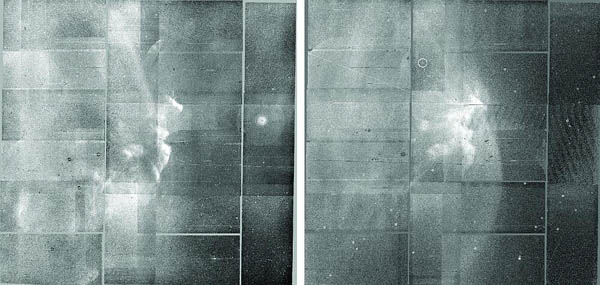 | |||
|
| Home > Public Information > Scientific Highlights > 2004 > The Largest Known Planetary Nebula on the Sky |
|
THE LARGEST KNOWN
PLANETARY NEBULA ON THE SKY
INT+WFC The vast majority of Planetary Nebulae in our own Galaxy have been identified via wide-field narrow-band Hα surveys or through wide-field low-resolution slitless spectroscopic surveys, with both techniques attempting to isolate objects showing very high equivalent width emission lines that are characteristic of PN. Examining the results of an automated search of the Sloan Digital Sky Survey (SDSS) spectroscopic database for emission lines from putative high-redshift sources, one particular galaxy showed an unambiguous emission line detection with a somewhat weaker feature to the blue. The emission line pair was immediately identifiable as emission from [OIII] 4959, 5007. Not an entirely unexpected occurrence but the unusual feature of the detection was that the wavelength of the detection placed the emission at essentially zero radial velocity. Querying the output of the emission line search for similar detections produced more spectra showing a similar signature. All of the objects possessing [OIII] emission occurred in an approximately circular region with a diameter of ~1.5°, with not a single detection anywhere else on the sky. Investigation of SDSS spectra of stars, quasars and even sky fibres revealed further detections, all concentrated in the same region of sky. A series of checks fairly rapidly eliminated the majority of instrumental artifacts or transient phenomena as the cause of the emission. Combining spectra beyond the boundaries of the region where [OIII] emission was detected produced clear detections of [OIII] emission extending over a region more than 2° in diameter. A smaller number of individual spectra also showed the presence of emission from Hα and [NII] 6548, 6583. The spatial distribution of the individual emission line detections revealed clear trends and composite spectra, made up from objects contiguous on the sky, confirmed the trends and even allowed the detection of [SII] 6718, 6732. Narrowband imaging of the central part of the region was carried out using the WFC. The results were unambiguous, with excellent agreement between the surface brightness distribution evident in the INT images and the emission line detections from the SDSS spectra. A striking feature of the images was the presence of a well-defined arc-like feature, perhaps suggestive of some form of shock. A search of the region using SIMBAD revealed the presence, close to the region with the strongest [OIII] emission, of a very nearby, extremely hot DO white dwarf (PG 1034+001). The location of the white dwarf clinched the identification of the emission region as a PN. The diameter of more than 2° makes the object the largest known PN on the sky. The spectroscopic distance estimate of 155+58 pc means the PN is certainly the second closest known and a parallax distance could confirm the nebula as the nearest PN to the Solar System. The unambiguous detection of a PN associated with a non-DA white dwarf is also a first. The PN is certainly old, an estimate of the expansion age and a kinematic age estimate, derived from extrapolating the observed proper motion of PG 1034+001 back to the origin of the radius of curvature of the arc feature, both suggest an age of ~100,000 years. The strongly enhanced [NII] emission evident along the south western boundary of the PN is also indicative of the interaction of an old PN with the surrounding interstellar medium.
Some references:
|
| Top | Back |
|


